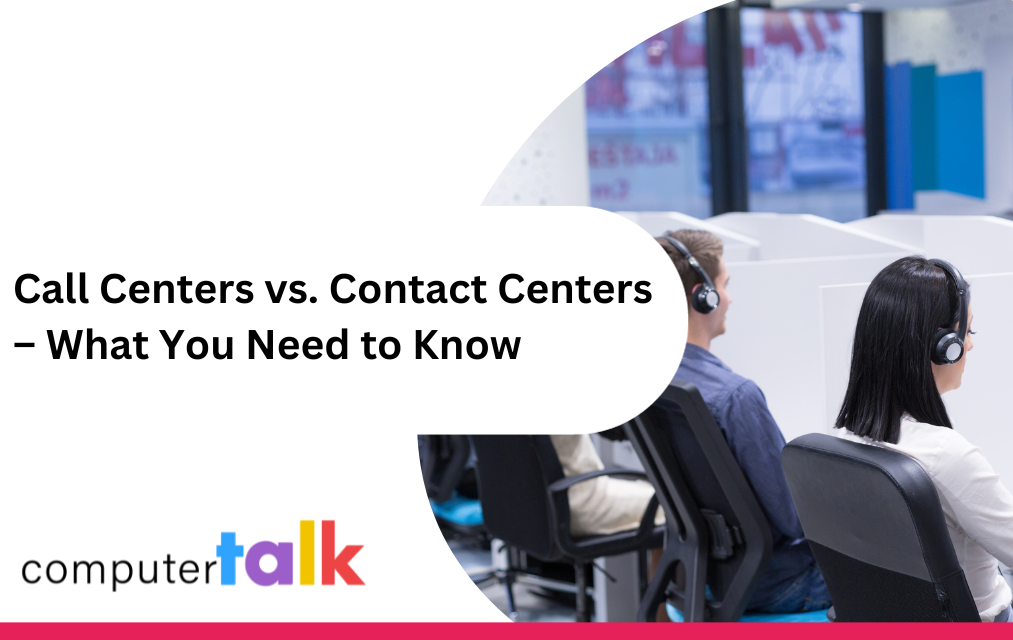Call Centers vs. Contact Centers – What You Need to Know
by Anastasia Micic | Published On January 25, 2024

Uncover the critical differences between call centers and contact centers, and choose the right model for enhanced customer service.
For numerous companies, the call center serves as the cornerstone of customer service. Traditionally, these centers have focused on phone-based support, earning them the name "call center."
However, as customer service has adapted to modern communication trends, call centers have expanded their reach. They now encompass a variety of interaction channels, not just phone calls, evolving into what are known as contact centers.
This transformation reflects the changing landscape of customer engagement, where versatility in communication methods is key to effective customer service.
It highlights the necessity for businesses to adapt, understand the call center vs contact center debate, and choose the right communication model that aligns with modern consumer preferences, ensuring an effective and versatile customer engagement strategy.
What Is a Call Center?
A traditional call center is a customer service hub primarily focused on voice communication. Its main function is to manage large volumes of inbound and outbound calls efficiently. The infrastructure of a traditional call center is optimized for call handling, featuring systems like telephony networks, Automatic Call Distributor (ACD) systems, and Interactive Voice Response (IVR) systems. This setup is designed to optimize call metrics and provide detailed call reports.
However, because of its focus predominantly on voice calls, a traditional call center might offer a more limited customer experience. The inconsistencies in customer service and information flow due to the lack of integration with other communication modes like email, chat, or social media, can potentially lead to a disjointed feel when customers interact through other channels.
In contrast, modern contact centers integrate multiple communication channels (like email, chat, and social media) and employ more advanced technologies such as AI and CRM systems, aiming for a seamless customer experience across all touchpoints.
While effective for businesses whose customers primarily interact via voice, traditional call centers lack the flexibility for future expansion into multi-channel communications, which can be a limitation in today's digitally diverse communication environment.
What Is an Omnichannel Contact Center?
A contact center is an advanced customer service solution that integrates various communication channels such as voice, email, SMS, live chat, social media, and video. It's designed to focus on holistic customer engagement, providing a connected experience across all touchpoints. This multi-channel communication approach is underpinned by comprehensive analytics, offering insights into customer interactions and behaviors.
An omnichannel contact center takes this further by ensuring seamless integration and consistency across all channels, providing a unified customer journey. Ideal for businesses whose customers use diverse digital channels, contact centers offer the flexibility to incorporate future media channels, making them scalable and adaptable to evolving communication trends. Such a setup is particularly suitable for businesses aiming for cross-channel reporting.
5 Key Differences between Contact Centers and Call Centers
1. Communication Channels
Call Centers are traditionally focused on voice calls, limiting their interaction to this single channel. In contrast, Contact Centers embrace a variety of communication methods, including phone, SMS, email, live chat, and social media, catering to a broader spectrum of customer preferences.
2. Customer Experience
The customer experience in Call Centers can be somewhat fragmented due to their sole reliance on voice calls, leading to inconsistencies and gaps in service across different customer interaction channels. Contact Centers, however, offer a more cohesive and integrated experience across different communication platforms. This is because they unify various modes of communication like email, chat, social media, and voice calls into a single, interconnected system, allowing for consistent and continuous customer engagement regardless of the chosen communication channel.
3. Expansion Capabilities
Call Centers encounter limitations with newer communication channels as they are primarily built for voice communication and may not readily support the integration of other technologies. In contrast, Contact Centers are specifically designed to integrate with multiple communication channels. This enables them to seamlessly integrate diverse channels such as voice, SMS, chatbots, live chat, and email into their operations, thus offering a more versatile and future-proof communication platform.
4. Technology and Training
Call Centers often use traditional, voice-centric technologies, which may not provide effective ways to track agent performance across multiple communication channels. In contrast, Contact Centers have advanced systems to manage all communication channels effectively. This enables supervisors to have comprehensive oversight of day-to-day operations, including detailed monitoring of each agent’s performance across various channels like chat, email, and social media. This requirement for advanced technology stems from the need to maintain consistency and efficiency in handling a broader range of customer interactions than what is typically encountered in traditional call centers.
5. Customer Preference and Competition
Organizations relying solely on Call Centers face the risk of not meeting modern customer preferences, as Call Centers typically do not offer non-voice channels. This limitation can result in missed opportunities for customer engagement and a competitive disadvantage, as they are unable to provide the comprehensive, multi-channel support that many customers now expect. In contrast, Contact Centers, with their integrated approach to various communication channels, are better positioned to fulfill these evolving customer needs, thereby offering a significant competitive advantage in customer service.
The Future of Contact Centers
In the future, contact centers will be shaped by AI, machine learning, and data analytics. Among the numerous advancements, the following four trends stand out as particularly important and relevant:
Streamlining Operations with AI: AI automation in contact centers significantly improves operational efficiency by handling repetitive tasks. Human agents can then concentrate on more complex customer interactions, enhancing the overall customer experience.
24/7 Customer Support: AI-driven systems enable contact centers to provide round-the-clock support. Continuous support is crucial in an era where consumers expect immediate responses, regardless of the time of day.
AI-Powered Analytics for Personalization: The ability of AI to analyze and extrapolate vast amounts of real-time data quickly is revolutionizing customer service. This technology enables more personalized interactions by understanding customer behaviors and preferences, significantly enhancing the quality of customer service. AI's rapid data processing not only provides immediate insights but also allows for real-time adaptation to customer needs, making each interaction more relevant and engaging.
Cost-Effectiveness of AI Solutions: Implementing AI in customer service can lead to significant cost reductions. By automating routine tasks, AI allows contact centers to handle more customer inquiries without expanding their workforce, thereby optimizing operational costs.
Which Option Is Suitable for Your Business?
Choosing between a call center and a contact center depends largely on how your customers prefer to interact with your business and what your service goals are. If your customers are primarily reaching out to your company via phone, then a call center is the optimal choice. This setup can efficiently handle high volumes of voice calls, which aligns well with your customers’ preferred communication method.
However, if your business wants to ensure an integrated customer experience by offering multiple communication channels like SMS, live chat, chatbots, and email, implementing a contact center is the way to go.
For a more detailed analysis and options tailored to your needs, explore more about call centers vs. contact centers.
More from our blog
 If you’ve ever sat down to review a call with an agent and found yourself thinking, “Where do I even start?”, you’re not alone. Many managers and supervisors have been there.
If you’ve ever sat down to review a call with an agent and found yourself thinking, “Where do I even start?”, you’re not alone. Many managers and supervisors have been there.
.png?sfvrsn=632ab5ac_1) Like many non-tech-oriented grads before me, my path to Tech was atypical. It was riddled with professional experiences from diverse industries such as Finance, Compliance, Education, and Consulting.
Like many non-tech-oriented grads before me, my path to Tech was atypical. It was riddled with professional experiences from diverse industries such as Finance, Compliance, Education, and Consulting.
 With the prevalent interconnected global marketplace, the dynamics of customer service are shifting rapidly. Remote contact centers are emerging not just as a novel concept but as a critical component for businesses.
With the prevalent interconnected global marketplace, the dynamics of customer service are shifting rapidly. Remote contact centers are emerging not just as a novel concept but as a critical component for businesses.

